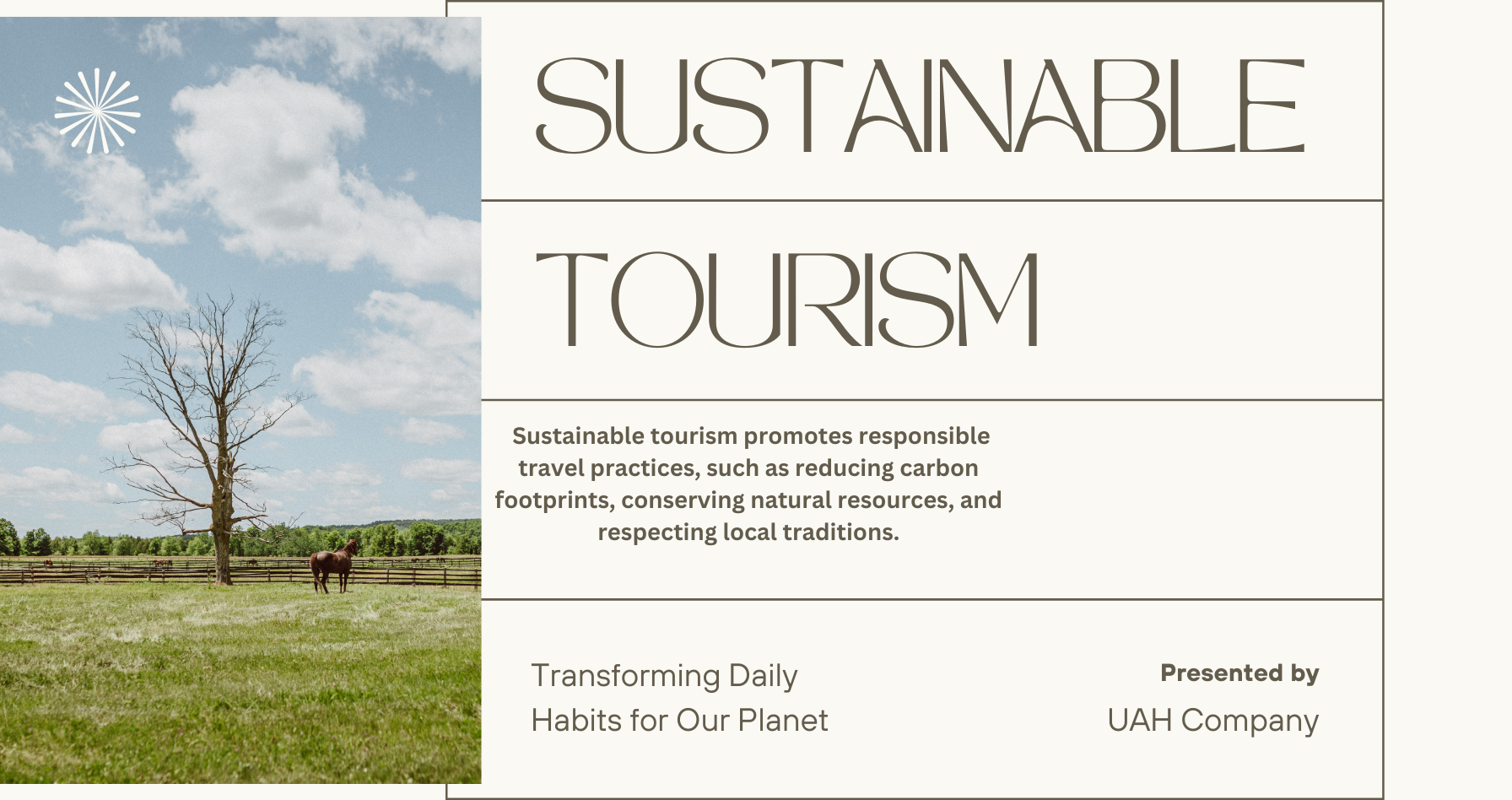Tourism is one of the fastest-growing industries globally, contributing significantly to economies and cultural exchanges. However, the rapid expansion of the travel sector has also led to environmental degradation, cultural erosion, and socio-economic imbalances. Sustainable tourism emerges as a crucial solution to counteract these negative effects, ensuring that tourism benefits both present and future generations. This blog explores why sustainable tourism is essential, its benefits, and how travelers, businesses, and governments can foster responsible travel practices.
What is Sustainable Tourism?
Sustainable tourism refers to travel that minimizes environmental impact, preserves cultural heritage, and supports local economies. It emphasizes long-term sustainability by balancing economic growth with ecological and social well-being. The World Tourism Organization (UNWTO) defines sustainable tourism as development that "meets the needs of present tourists and host regions while protecting and enhancing opportunities for the future."
Key Aspects of Sustainable Tourism
Environmental Responsibility – Reducing carbon footprints, conserving biodiversity, and minimizing waste.
Economic Benefits – Ensuring fair wages, supporting local businesses, and reinvesting in the community.
Cultural Preservation – Protecting local traditions, respecting indigenous knowledge, and promoting authentic experiences.
Social Inclusivity – Encouraging responsible tourism that benefits host communities and promotes mutual respect.
The Importance of Sustainable Tourism
1. Protecting Natural Resources
Tourism heavily relies on natural attractions such as beaches, forests, and wildlife. Unchecked tourism can lead to deforestation, pollution, and habitat destruction. Sustainable tourism promotes conservation efforts by encouraging eco-friendly travel options, responsible wildlife encounters, and waste reduction initiatives.
2. Combating Climate Change
The travel industry contributes significantly to global carbon emissions, primarily through air travel and energy-intensive accommodations. Sustainable tourism advocates for green tourism practices, such as carbon offset programs, energy-efficient hotels, and alternative transport methods like cycling and electric vehicles.
3. Supporting Local Communities
Tourism can provide immense economic benefits to local communities, but irresponsible tourism often leads to economic exploitation. Sustainable tourism ensures fair wages, supports local artisans and businesses, and promotes community-led initiatives, thereby fostering inclusive economic growth.
4. Preserving Cultural Heritage
Mass tourism often results in the commercialization and dilution of cultural traditions. Sustainable tourism respects and promotes cultural heritage by encouraging authentic, locally-driven experiences. It ensures that tourism contributes to the preservation of historical sites, languages, and indigenous practices rather than eroding them.
5. Enhancing Travel Experience
Sustainable travel offers more meaningful and immersive experiences. Travelers who engage in responsible tourism often gain a deeper appreciation for destinations through interactions with local communities, participation in conservation projects, and eco-friendly adventures.
How to Practice Sustainable Tourism?
For Travelers:
Choose Eco-Friendly Accommodations – Stay at hotels that prioritize sustainability, such as those with green certifications (LEED, EarthCheck, etc.).
Reduce Plastic Usage – Carry reusable water bottles, bags, and toiletries to minimize plastic waste.
Respect Local Cultures – Learn about the traditions and customs of the places you visit and adhere to local etiquette.
Support Local Businesses – Buy souvenirs from local artisans, eat at locally-owned restaurants, and hire local guides.
Use Sustainable Transportation – Opt for public transport, biking, or walking instead of rental cars and flights whenever possible.
Be a Responsible Wildlife Tourist – Avoid attractions that exploit animals, such as elephant rides or marine shows with captive dolphins.
For Businesses:
Adopt Eco-Friendly Practices – Reduce waste, use renewable energy, and implement water conservation techniques.
Engage in Ethical Tourism – Ensure that tourism activities respect human rights and fair labor practices.
Educate Tourists – Inform visitors about responsible travel behavior and local conservation efforts.
Collaborate with Local Communities – Support community-led tourism initiatives and ensure economic benefits reach local populations.
For Governments:
Regulate Over-Tourism – Implement visitor caps, enforce entry fees, and establish conservation zones.
Promote Sustainable Tourism Policies – Introduce laws that encourage responsible tourism and penalize environmental violations.
Invest in Green Infrastructure – Develop eco-friendly transport options and sustainable urban planning.
Encourage Ecotourism Initiatives – Support programs that focus on environmental conservation and community-based tourism.
Examples of Sustainable Tourism Initiatives
1. Costa Rica: A Model for Ecotourism
Costa Rica is a global leader in sustainable tourism, with over 25% of its land designated as protected areas. The country promotes eco-lodges, wildlife conservation programs, and carbon-neutral tourism strategies, making it a prime destination for responsible travelers.
2. Bhutan’s High-Value, Low-Impact Tourism
Bhutan follows a unique tourism policy that prioritizes sustainability by charging tourists a daily fee that funds environmental and cultural preservation efforts. This model ensures that tourism benefits both visitors and local communities.
3. The Slow Tourism Movement in Italy
Italy encourages slow tourism, which emphasizes deeper cultural immersion, sustainable transport, and support for local businesses. Travelers engage in activities like farm stays, cycling tours, and heritage conservation projects.
Challenges in Implementing Sustainable Tourism
Despite its benefits, sustainable tourism faces several challenges:
1. High Costs: Eco-friendly accommodations and sustainable travel options can be expensive.
2. Lack of Awareness: Many travelers and businesses remain unaware of the importance of sustainable tourism.
3. Over-Tourism in Fragile Destinations: Popular locations like Venice, Machu Picchu, and Bali struggle with excessive tourist footfall, leading to environmental strain.
4. Balancing Economic and Environmental Priorities: Developing nations reliant on tourism revenue may find it challenging to prioritize sustainability over short-term economic gains.
The Future of Sustainable Tourism
The future of travel must be centered on sustainability. Governments, businesses, and travelers must work together to create a responsible tourism industry that prioritizes conservation, community well-being, and cultural preservation. Emerging trends such as eco-luxury resorts, carbon-neutral airlines, and regenerative tourism—where travelers actively contribute to environmental restoration—are shaping the future of travel.
Conclusion
Sustainable tourism is not just a trend; it is a necessity for the future of our planet. By adopting responsible tourism practices, we can protect the environment, support local communities, and preserve cultural heritage while still enjoying the wonders of travel. Whether you are a traveler, a business, or a policymaker, making sustainable choices will ensure that future generations can experience the beauty of the world just as we do today.
Embrace sustainable tourism—travel responsibly, protect nature, and leave a positive impact on the world!




.jpg)

.jpg)